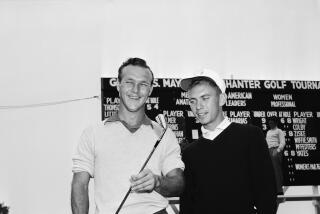BOWLING ON THE GREEN : Participants in This Ages Old Sport Find There’s Plenty of Skill, Strategy and No Yawning on These Lawns
SAN DIEGO — By 1976, Loretta Geisner had had it.
She had tried badminton, bowling and golf without much success. She had done all sorts of volunteer work, including being a scorekeeper for her sons’ Pony League baseball teams and a Girl Scout leader, despite the fact that she did not have a daughter. She was a paid teacher’s aide, but that too was unsatisfying.
She had arthritis in her knees so bad that she needed assistance to get out of the car. But, at 55, she was not willing to sit home all day.
“I needed something to fill the void in my life,” Geisner said. “I wanted to do something for me for a change.”
Eleven years later, Geisner is one of the U.S.’s best women lawn bowlers. She is a past U.S. Open singles champion and she and her partner from the San Diego Lawn Bowling Club, Sunny Forbess, have qualified for the the 1987 U.S. National Pairs Playdowns in Wilmington, Del., in October.
Geisner is 66. Her age puts her in the group that most people think of when they hear the words lawn bowling--senior citizens. But that is not the only group who play.
“They say lawn bowling is an old man’s game,” said Jack Williams, a member of the board of the American Lawn Bowling Assn. from San Diego. “But that’s wrong. It’s a game that old men can play.”
It’s definitely not only a sport for senior citizens. Most of the world’s best players are between 22 and 40, according to Ernest De Leon, who at 39, says he is almost past his prime.
For Geisner, her bowling with the San Diego club has offered chances for travel and parties throughout the U.S. and Canada. And the exercise she gets has helped reduce the pain from her arthritis, she says.
“We don’t promise a cure for arthritis,” said George Sincerbox, president of the San Diego club. “But it is a way to get people out of the house and away from the television.”
Lawn bowling, or bowls as they are called by players, has become much more than that for Geisner. She devotes most of her time to improvement.
Trying to become a better player even takes some of her spare time. Geisner said she’ll bowl a whole game in her head while lying in bed. She thinks of different situations and then imagines the perfect shot.
Although Geisner had won the U.S. Open singles title in 1983, she kept just missing qualification for the prestigious National Pairs. She was failing, she says, because she didn’t have “that killer instinct.” She lost in the final game of nine three times before qualifying this year. She and Forbess qualified by winning the Southwest Division Pairs tournament at Newport Beach in June.
“I think (the imaginary games) have helped my mental attitude a lot,” said Geisner, who also teaches at the San Diego club. “I had long talks with myself this year to keep my mental attitude from defeating me.”
When Geisner first went to her first tournament in 1978, she said it was exciting.
“The adrenalin flow was something I had never experienced before,” she said. “I saw the possibility for improvement. It gave me a real purpose.”
Exciting? That is not the first association that comes to mind with lawn bowling. But being a top player requires a great deal of concentration.
Players (usually three on a team) try to roll their bowl as close as they can to a small white ball called the jack. It can be difficult to reach the ball when there are a lot of other bowls around the jack. Players have to try to knock opponents’ bowls out of the way while not disturbing their own bowls. What makes it difficult is the bowls are not balanced, and the weight on one side makes them curve.
Every green is different so players have to try to read the green to see how to roll. Concentration and experience mean a lot in bowls.
De Leon, who is employed at the San Diego water works, may not have as much experience as some bowlers, but he said his concentration level allows him to play on the same level with more experienced bowlers.
“There are times when I’m bowling and nothing can go wrong,” De Leon said. “I just have a natural feeling for the game.”
His “feeling” for the game has helped him to come a long way in a short time. After playing only eight months, De Leon competed in the U.S. Pairs Playdowns in 1985. He didn’t win the tournament, but he did win a few matches and gained a lot of confidence.
Last Saturday, he had an off day and didn’t make the finals at the ALBA Southwest Division Pairs tournament at San Diego. Most of the others in the tournament had been bowling three or four times as long, but De Leon thinks that is to his benefit.
“By playing with people who have bowled for a long time,” I benefit from their experience,” De Leon said. “One guy teaches me how to use the mat properly. A 98-year-old Canadian named Joe Crawford once mentioned using a pendulum swing (a technique for rolling the bowl). I tried it and it was best for me. That’s why I can compete at this level after such a short time.”
Making the U.S. team is De Leon’s ultimate goal. He figures he can do it within five to seven years with continued practice.
Because he often works nights, De Leon has more time to practice.
“A lot of younger people don’t bowl because they work during the day,” De Leon said. “I don’t have that problem.”
Though it’s tough to come off a graveyard shift and train, DeLeon said, the sport means enough to him that he belongs to two clubs and bowls as much as possible.
De Leon used to wrestle and play football until he suffered a dislocated shoulder. He tried racquetball, but that was painful, too.
“But lawn bowling doesn’t seem to bother it,” De Leon said. “It is a strain physically. After a match, your whole body feels tired. And the level of concentration is so high that you are drained by the end of the day.”
More to Read
Go beyond the scoreboard
Get the latest on L.A.'s teams in the daily Sports Report newsletter.
You may occasionally receive promotional content from the Los Angeles Times.










